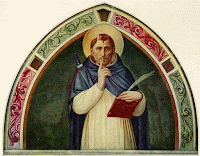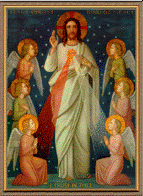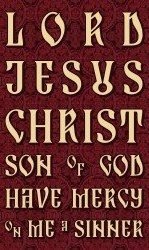+
The Lutheran Hymnal published in the USA is as sacred to some traditional Lutherans as The Hymnal 1940 is to some traditional Episcopalians in the USA. Of course, there are other traditionally-minded Lutherans in the USA for whom THE hymnal is The Service Book and Hymnal which contained the first Lutheran Eucharistic Prayer since the Reformation... but I digress.
In The Lutheran Hymnal we find a lovely Epiphany hymn:
The star proclaims the King is here;
But, Herod, why this senseless fear?
He takes no realms of earth away
Who gives the realms of heavenly day.
The wiser Magi see from far
And follow on His guiding star;
And led by light, to light they press
And by their gifts their God confess.
Within the Jordan's crystal flood
In meekness stands the Lamb of God
And, sinless, sanctifies the wave,
Mankind from sin to cleanse and save.
At Cana first His power is shown:
His might the blushing waters own
And, changing as He speaks the word,
Flow wine, obedient to their Lord.
All glory, Jesus, be to Thee
For this Thy glad epiphany;
Whom with the Father we adore
And Holy Ghost forevermore.
From The Lutheran Liturgical Prayer Brotherhood we have an mp3 recording of the above text sung to the chant melody No. 28 ... which for some of us makes it clear that the above is a translation of the Epiphany chant Hostis Herodes impie (which has two Latin versions). Not only is it that, but it is also an altered form of an original translation by that sainted Anglican the Revd Dr John Mason Neale.
There are many altered versions of Dr Neale's translation such as the following:
1. When Christ's appearing was made known,
King Herod trembled for his throne;
But He Who offers heavenly birth
Sought not the kingdom of this earth.
2. The eastern sages saw from far
And followed on His guiding star;
By light their way to Light they trod,
And by their gifts confessed their God.
3. Within the Jordan's sacred flood
The heavenly Lamb in meekness stood,
That He, to Whom no sin was known,
Might cleanse His people from their own.
4. And O what miracle divine,
When water reddened into wine!
He spake the word, and forth it flowed
In streams that nature ne'er bestowed.
5. All glory, Jesus, be to Thee
For this Thy glad epiphany:
Whom with the Father we adore
And Holy Ghost forevermore.
And as Dr Neale's translation appeared in the 1908 edition of GR Woodward's Songs of Syon:
1. Why, impious Herod, vainly fear
That Christ the Saviour cometh here?
He takes not earthly realms away,
Who gives the crown that lasts for aye.
2. To greet his birth the Magi went,
Led by the star before them sent:
Called on by light, to Light they press’d,
And by their gifts their God confess’d.
3. In holy Jordan’s purest wave
The heavenly Lamb vouchsafed to lave;
That he, to whom was sin unknown,
Might cleanse his people from their own.
4. New miracle of power divine!
The water reddens into wine:
He spake the word, and pour’d the wave
In other streams than nature gave.
5. All glory, Lord, to thee we pay,
For thine Epiphany to-day;
All glory, as is ever meet,
To Father and to Paraclete. Amen.
And yet again, another variation reflecting the revised version of the Latin original:
How vain the cruel Herod’s fear,
When told that Christ the King is near!
He takes not earthly realms away,
Who gives the realms that ne’er decay.
The Eastern sages saw from far
And followed on His guiding star;
By light their way to Light they trod,
And by their gifts confessed their God.
Within the Jordan’s sacred flood
The heavenly Lamb in meekness stood,
That He to whom no sin was known,
Might cleanse His people from their own.
And oh, what miracle divine,
And oh, what miracle divine,
When water reddened into wine!
He spake the word, and forth it flowed
In streams that nature ne’er bestowed.
All glory, Jesu, be to Thee
For this Thy glad Epiphany:
Whom with the Father we adore
And Holy Ghost forevermore.
Editors of hymnals cannot resist the temptation to tinker with the text of an hymn in English and often that tinkering impulse moves from temptation to flagrant sin with regard to the integrity of a translator's poetic text. Fortunately, the original and the many alterations of Dr. Neale's translation all reveal insights into the original text that are salutary ... even as they sometimes also needlessly accommodate the unrelenting drive to put the Prayer Book English into today's new-speak.
One should note that the version in The Lutheran Hymnal intentionally alters the first stanza and the first line by taking the emphasis away from Herod and placing it on the Star of Bethlehem and Jesus our King. It was because of the birth of Jesus the King and the Guiding Star that Herod was put in a panic after all. There is a great deal of merit to the alterations and overall shape and tenor of the version found in The Lutheran Hymnal.
The Latin original is credited to Coelius Sedulius ca. A.D. 450 and was taken from a much larger hymn of his. The Latin text was revised which also adds to the many translations, alterations, and variations on Sedulius' original text. The Christmas chant A solis ortus cardine also comes from the same longer hymn by Sedulius. +
Setting by Pedro de Escobar
+ + +
To my mind the restyling of the time after Epiphany as Epiphanytide is far better than "Ordinary Time". The patterns for such a church season can be found in some English language liturgical books of Lutherans and Episcopalians/Anglicans wherein they unite the three original commemorations of the Feast of the Epiphany (i.e., the Manifestation of Christ to the Magi, the Baptism of Christ in the River Jordan, and the First Miracle at Cana in Galilee) within the Season of Epiphany but spread out upon 3 separate occasions.
The additional Sunday Eucharistic liturgical texts of in the construction of this season all express in one fashion or another the Manifestation and Revelation of Jesus Christ to the World culminating in either a celebration of the Transfiguration at the level of a feast on the last Sunday of this season or simply with the Transfiguration of Our Lord as the subject of the prayers and Gospel for the Last Sunday after Epiphany.
In the Eastern Orthodox Churches the Feast of the Theophany of Christ celebrates all three events including the paraliturgical blessing of the waters with the priest throwing the cross of blessing into the waters to be retrieved by young men ... a genuine act of festival that unites the liturgy to the public square, so to speak.
The current Novus Ordo Roman Lectionary puts the Gospel reading of the Transfiguration squarely within Lent where it has its own rhyme and reason within the schema of the Eucharistic three-year Lectionary.
For my own part I would want a Lectionary in which the Transfiguration Gospel is read on the culminating Sunday of Epiphanytide and would then be read again on the Sunday before Palm Sunday as well as the proper Feast on August 6th.
Of course, dear Reader, I should confess that the Feast of the Transfiguration has been for me at a very personal level my favourite traditional Feast of Our Lord and His Ministry in the Western Christian Kalendar. Naturally, I should want the Transfiguration Gospel read and proclaimed as often as possible.
God and man made manifest!















